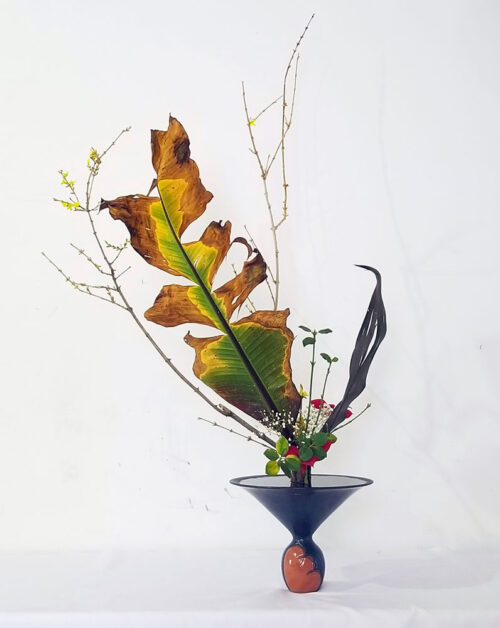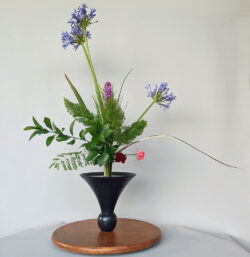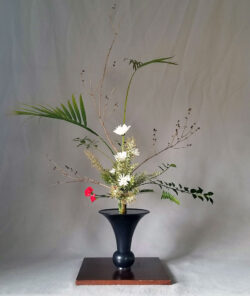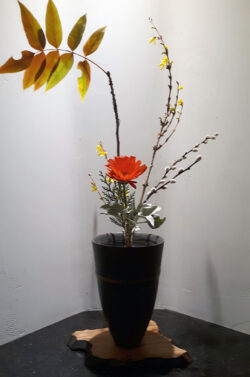Students for our workshop on Sunday had a choice to create either a traditional rikka shofutai or a modern rikka shimputai arrangement. Professor Jeanne Holy started the workshop by asking if this was the first time anyone had chosen their own materials when creating a rikka. Then she provided some hints and guidelines to use when limited materials are available. Choosing your own material can be difficult, challenging, and rewarding. It is amazing how much material you can find in your own yard. Looking in your yard and closely observing your materials is a great learning experience and is almost like preparing to teach a class.
When you have limited materials, the easiest way to obtain a balance is to use the sankashozukai configuration. This means the same material is used for three yakueda in the upper, middle, and lower levels on the IN and YO sides. For example, shin, uke, and hikae would use the same material, and soe, mikoshi, and nagashi would use the same material. There are some exceptions to this. For example, if the material used for soe and mikoshi grows upward, you should choose a different material for nagashi. Material used for nagashi should use a material that can grow sideways. This helps to create balance in the arrangement. You do not have to use ashirai. Your do and ushirogakoi should be a different material.
Jeanne gave extremely helpful hints and guidelines when creating rikka shimputai as well.
When creating a rikka shimputai, balance is a huge factor. In this rikka there is only shu and yo. All the other branches are ashirai. The mizugiwa is also shorter in shimputai. You must be in love with your SHU material and then find a YO material to enhance your shu even more. Create a feeling of in and yo using your materials. There is a feeling of brightness and sharpness that is associated with shimputai.
Next, Jeanne provided some hints for choosing and using different containers for rikka arrangements.
When creating a rikka, it is sometimes difficult to find floral material that are tall enough. Alstroemeria and carnations are good choices as they are generally tall. You can compensate for material that is not tall enough by using a taller vase and creating a smaller rikka. The de of rikka is considered to be where life begins. Remember that the de of shin is about 20 cm and the total height of shin is around 80 cm. If you need to compensate for shorter materials make the de of shin about 1/4 the height of shin. The de of other yakueda is determined from the de of shin. This shorter de of shin results in a compression of the space between the de of shin and the mizugiwa or, shin and uke, uke and hikae, and hikae and nagashi. Even though there is less space between the different departure points each de must be different.
Lastly, Jeanne gave some hints for taking photos of your arrangements.
Do not fill your container all the way up with water until it has been reviewed and you have made any corrections or changes. When your arrangement is ready to be photographed, make sure the water is filled all the way up and take the photo level with the arrangement so the mizugiwa can be clearly seen.
Our thanks to Jeanne for a wonderful and informative workshop. Enjoy the photos!











